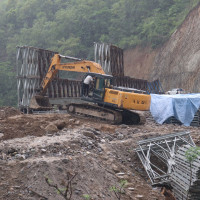- Wednesday, 6 August 2025
Monetary policy review
Central Bank adjusts bank rate, policy rate
By Laxman Kafle,Kathmandu, Dec. 9 : Nepal Rastra Bank (NRB) has adjusted the bank rate and policy rate through its first-quarterly (mid-July to mid-October) review of the monetary policy of the current Fiscal Year 2023/24.
The NRB on Friday made public the first quarterly review of the monetary policy by reducing both the bank rate and policy rate, exhibiting flexibility in its policy. The bank rate has been reduced to 7 per cent from 7.5 per cent and the policy rate is brought down to 5.5 per cent from 6.5 per cent.
Bank rate is the interest rate charged by the central bank to the banks and financial institutions which is intended to influence the base rate of the BFIs. Likewise, the policy rate is a short-term interest rate charged by a bank while lending to other banks.
According to the NRB, the bank rate and the policy rate have been reduced given the analysis of various factors affecting the existing inflation, balance of payment and the growth rate of bank loans going to the private sector.
Similarly, the interest rate on deposits collection through bids has been reduced to 3 per cent from 4.5 per cent. The NRB has taken the initiative to reduce the interest rate, it said in its review.
Mandatory cash reserve ratio and statutory liquidity ratio have, however, remained unchanged, said the NRB.
Risk-weightage of share mortgage and real estate loans lowered
The NRB has reduced the risk weightage of large loans going to securities. The risk weightage of more than Rs. 5 million share mortgage loan has been maintained at 125 per cent. Previously, such risk weightage was 150 per cent.
Likewise, the risk weightage of share mortgage loans below Rs. 5 million has remained at 100 per cent. The objective of the monetary policy review was to make the stock market viable by reducing the risk weightage in share mortgage loans.
Similarly, the risk weightage of real estate loans of more than Rs. 5 million has also been reduced to 125 per cent. Previously, the risk weightage in real estate loans of more than Rs. 5 million was 150 per cent.
In addition, a provision has been made to increase the monthly instalment income ratio to 60 per cent when taking a housing loan of up to Rs. 5 million. Earlier this ratio was only 50 per cent.
Low-interest rates to build earthquake-damaged houses
The NRB has made a provision to provide loans for the reconstruction of residential houses damaged by the earthquake of November 3, 2023, that damaged scores of houses in Jajarkot and Rukum West districts at a subsidised interest rate.
"When BFIs give residential house loans of up to Rs. 2.5 million to the families which have been listed as earthquake victims by the agencies designated by the government, it will be arranged that no more than 2 percentage points of premium can be added to the base rate," said the NRB.
For this purpose, the banks and financial institutions can add up to 10 percentage points or more to the existing loan-to-mortgage ratio, according to NRB.
Similarly, for the reconstruction of public schools, public hospitals and health posts damaged by the earthquake, the banks and financial institutions can contribute up to 40 per cent of the amount to be spent separately to the corporate social responsibility fund from the profits of the fiscal year 2022/23 and 2023/24.
The NRB has also arranged that 50 per cent of debentures issued by banks and financial institutions can be counted as resources until mid-July 2024.
"Even there is a provision that the debentures issued by banks and financial institutions can be counted as resources at 100 per cent until mid-January 2024, after which 50 per cent of the debentures will be counted as resources until mid-July 2024," said the NRB.
Borrowers with problems allowed to restructure loans
The NRB has stated that by making the action on the borrowers, who deliberately do not pay their loans, more effective in the banking and financial sectors, the borrowers who are in trouble due to circumstances will be facilitated through loan restructuring and rescheduling.
For this purpose, based on the analysis of the applications received from the borrowers in trouble, banks and financial institutions can collect 10 per cent of the outstanding interest and restructure the loan until April 12, 2024, and the areas that can be restructured will be expanded.
The central bank is also going to facilitate the microfinance borrowers who are in contact.
A policy has been adopted to facilitate the borrowers who are in regular contact with microfinance financial institutions (MFIs) but are unable to continue paying their loans due to various circumstances.
According to the NRB, arrangements will be made to restructure the loans of such borrowers if they submit an application to the MFIs for such loan restructuring by April 12, 2024.
A monetary policy advisory committee will be formed, including external experts, to make suggestions regarding the direction, structure, goals and tools of monetary policy, said the NRB.

















